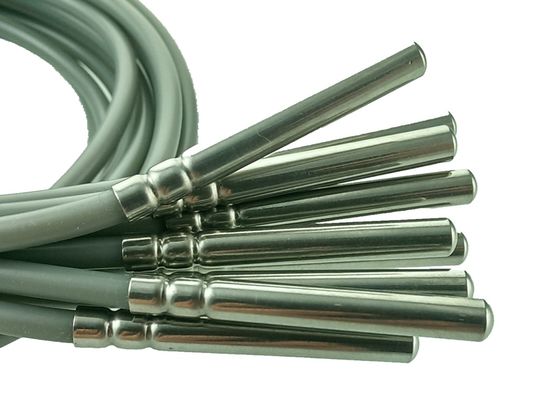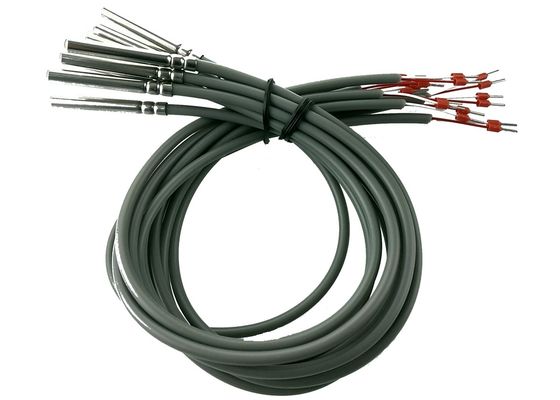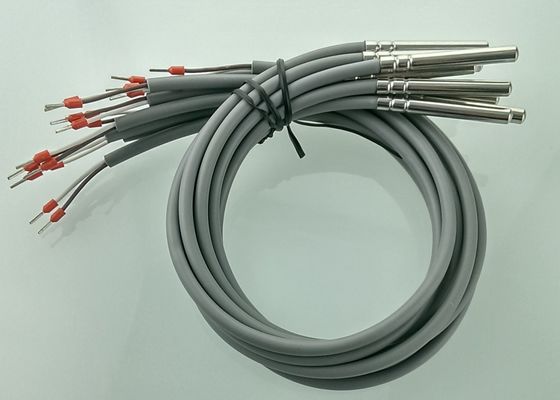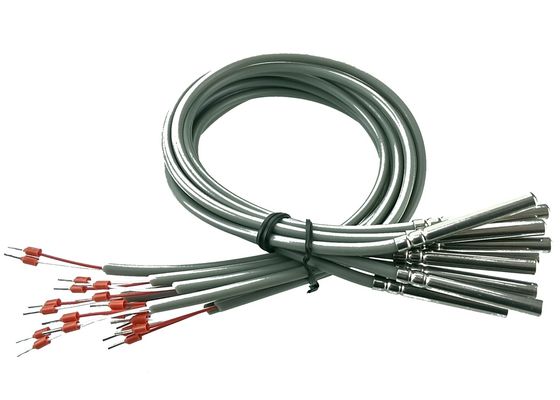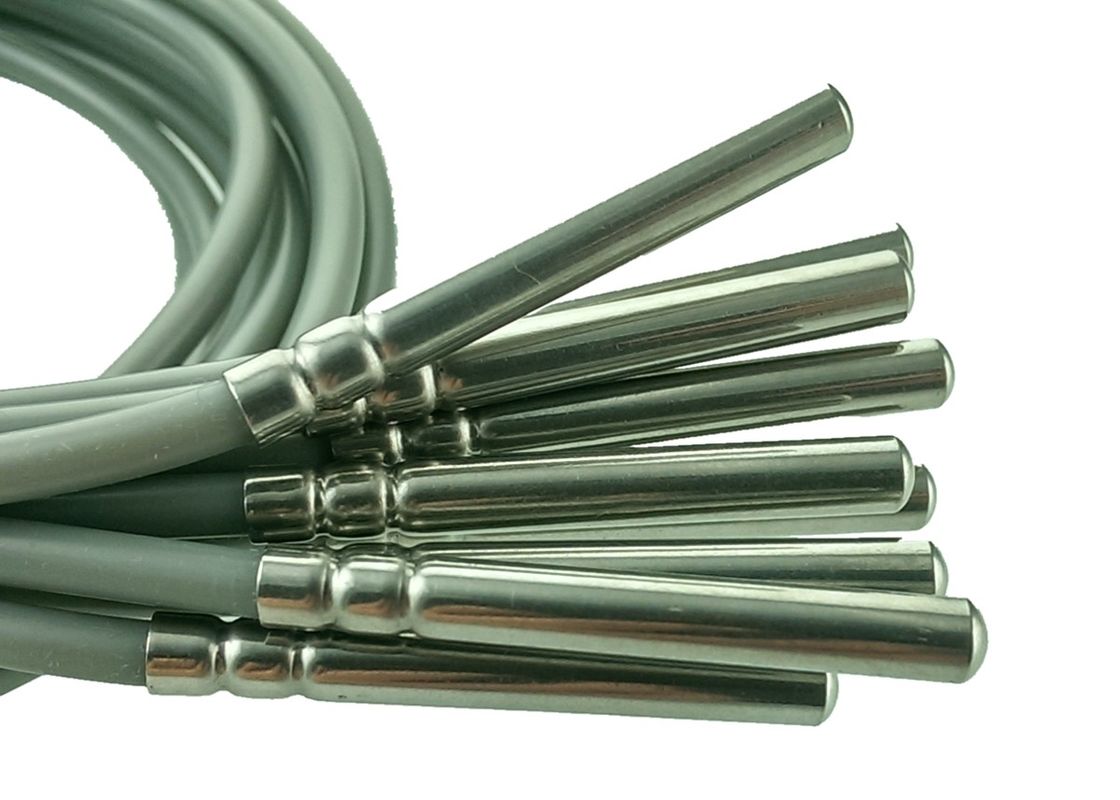RTD Class B PT100 6x50mm Micro Temperature Sensor
Product Details:
| Brand Name: | Aolittel |
| Model Number: | PT100B-2100L6D50T |
Payment & Shipping Terms:
| Minimum Order Quantity: | 800 Pieces |
|---|---|
| Price: | Negotiable |
| Packaging Details: | Bulk |
| Delivery Time: | 2-4 Weeks |
| Payment Terms: | T/T,Paypal |
| Supply Ability: | 1,000,000 Pieces Per Month |
|
Detail Information |
|||
| Product Name: | PT100 Temperature Sensor | Chip: | RTD PT100 CLASS B |
|---|---|---|---|
| Housing: | Φ6.0×50mm Stainless Steel (SUS304) | Cable: | PVC 80℃ AWG24*2 OD5.2 (Gray) |
| Terminal: | E0508 Tubular Insulated Terminals (Red) | Nominal Resistance At 0℃: | 100Ω |
| Highlight: | PT100 Micro Temperature Sensor,50mm Micro Temperature Sensor,rtd pt100 temperature sensor |
||
Product Description
RTD Class B PT100 Platinum Resistance Micro Temperature Sensor 2 Meter Length With 6x50mm Stainless Steel 304 Housing
Benefits of Using an RTD
The RTD is one of the most accurate temperature sensors. Not only does it provide good accuracy, it also provides excellent stability and repeatability. Most OMEGA standard RTDs comply with DIN-IEC Class B. RTDs are also relatively immune to electrical noise and therefore well suited for temperature measurement in industrial environments, especially around motors, generators and other high voltage equipment.
__________________________________________________________________________![]() Download________
Download________
Dimension (mm)
![]()
| NO | Material Name | Item/PN |
| 1 | Housing | Φ6.0×50mm Stainless Steel (SUS304) |
| 2 | Element | Platinum Resistance: PT100 (Class B) |
| 3 | Coating | Epoxy Resin |
| 4 | Lead Wire | PVC 80℃ AWG24*2(Red and White) OD5.2 (Gray) |
| 5 | Terminal | E0508 Tubular Insulated Terminals (Red) |
| P/N | Nominal resistance at 0℃(Ω) | Resistance Tolerance at 0℃ | Tolerance grade | Withstand voltage test (Sec) | Insulation resistance (MΩ) | Operating temp. range |
| Pt100 | 100 | ±0.30℃ | B | Shell and wires between AC1750V for 2S, no breakdown, flashover phenomenon | Between the shell and wires DC500V, water > 100MΩ insulation resistance measurement | -45℃~180℃ |
Resistance Temperature Chart
|
T (℃) |
0 | 1 | 2 | 3 | 4 | 5 | 6 | 7 | 8 | 9 |
| Resistance(Ω) | ||||||||||
| -50 | 80.31 | |||||||||
| -40 -30 -20 -10 0 |
84.27 88.22 92.16 96.09 100.00 |
83.87 87.83 91.77 95.69 99.61 |
83.48 87.43 91.37 95.30 99.22 |
83.08 87.04 90.98 94.91 98.83 |
82.69 86.64 90.59 94.52 98.44 |
82.29 86.25 90.19 94.12 98.04 |
81.89 85.85 89.80 93.73 97.65 |
81.50 85.46 89.40 93.34 97.26 |
81.10 85.06 89.01 92.95 96.87 |
80.70 84.67 88.62 92.55 96.48 |
| 0 10 20 30 40 |
100.00 103.90 107.79 111.67 115.54 |
100.39 104.29 108.18 112.06 115.93 |
100.78 104.68 108.57 112.45 116.31 |
101.17 105.07 108.96 112.83 116.70 |
101.56 105.46 109.35 113.22 117.08 |
101.95 105.85 109.73 113.61 117.47 |
102.34 106.24 110.12 114.00 117.86 |
102.73 106.63 110.51 114.38 118.24 |
103.12 107.02 110.90 114.77 118.63 |
103.51 107.40 111.29 115.15 119.01 |
| 50 60 70 80 90 |
119.40 123.24 127.08 130.90 134.71 |
119.78 123.63 127.46 131.28 135.09 |
120.17 124.01 127.84 131.66 135.47 |
120.55 124.39 128.22 132.04 135.85 |
120.94 124.78 128.61 132.42 136.23 |
121.32 125.16 128.99 132.80 136.61 |
121.71 125.54 129.37 133.18 136.99 |
122.09 125.93 129.75 133.57 137.37 |
122.47 126.31 130.13 133.95 137.75 |
122.86 126.69 130.52 134.33 138.13 |
| 100 110 120 130 140 |
138.51 142.29 146.07 149.83 153.58 |
138.88 142.67 146.44 150.21 153.96 |
139.26 143.05 146.82 150.58 154.33 |
139.64 143.43 147.20 150.96 154.71 |
140.02 143.80 147.57 151.33 155.08 |
140.40 144.18 147.95 151.71 155.46 |
140.78 144.56 148.33 152.08 155.83 |
141.16 144.94 148.70 152.46 156.20 |
141.54 145.31 149.08 152.83 156.58 |
141.91 145.69 149.46 153.21 156.95 |
| 150 160 170 180 190 |
157.33 161.05 164.77 168.48 172.17 |
157.70 161.43 165.14 168.85 172.54 |
158.07 161.80 165.51 169.22 172.91 |
158.45 162.17 165.89 169.59 173.28 |
158.82 162.54 166.26 169.96 173.65 |
159.19 162.91 166.63 170.33 174.02 |
159.56 163.29 167.00 170.70 174.38 |
159.94 163.66 167.37 171.07 174.75 |
160.31 164.03 167.74 171.43 175.12 |
160.68 164.40 168.11 171.80 175.49 |
| 200 | 175.86 | 176.22 | 176.59 | 176.96 | 177.33 | 177.69 | 178.06 | 178.43 | 178.79 | 179.16 |
TECHNICAL DATA- RESPONSE TIME
PLATINUM THIN FILM RTD TEMPERATURE SENSOR ELEMENT
Response time to 63.2% (time constant) and 90% of temperature shift in stir water and still air when temperature shift from T1 to T2 is 100% is as follow.
![]()
| TYPE | SIZE | STIR WATER | STILL AIR | ||||||
|---|---|---|---|---|---|---|---|---|---|
| 63.2% | 90% | 63.2% | 90% | ||||||
| PLATINUM THIN FILM RTD TEMPERATURE SENSOR ELEMENT | 1632 | 0.3 | 0.7 | 4.3 | 9.9 | ||||
| 2005 | 0.4 | 0.9 | 4.8 | 11.1 | |||||
| TYPE OF ELEMENT | THIN FILM RTD TEMPERATURE SENSOR ELEMENT |
|---|---|
| TEST TEMP. | T1:LOW TEMP. T2:HIGH TEMP. |
| TEST METHOD | The product's measuring point is set in room temperature. Then, the response time is?measured at time constant and 90% of response time after it is put in stir water and still air that have enough temperature difference with room temperature, instantly. Response time is an average of T1 |
| STANDARD | JIS C1604 RTD |
Notification
This data is measured in a specified environment.
By the actual measuring environment, and condition, the result will be different.
PT100 Element Specification
| PRODUCT CODE | CRZ1632R-100 |
|
|
|---|---|---|---|
| CLASS | F0.1(1/3B), F0.15(A), F0.3(B), F0.6(2B) | ||
| TEMP. RANGE | F0.1(1/3B) | -20 to 150 (-4 to+302 F) |
|
| F0.15(A) | -40 to 300 (-40 to+572 F) |
||
| F0.3(B) | -70 to 400 (-94 to+752 F) |
||
| F0.6(2B) | -70 to 400 (-94 to+752 F) |
||
| DIMENSION(mm) (WxLxH) | 1.6x3.2x1.1 | ||
| THE NUMBER OF ELEMENT | SINGLE | ||
| RESISTANCE VALUE | Pt 100 | ||
| MEASUREMENT CURRENT | LESS THAN 1 mA | ||
| LEAD WIRE'S MATERIAL | Au-Plated Nickel | ||
| LEAD WIRE'S DIMENSION (mm) (DxL) |
φ0.2x11 | ||
| TEMPERATURE COEFFICIENT RESISTANCE (TCR) | 0.003851 | ||
| STABILITY | 200 |
||
| 400 |
|||
| RESPOSE TIME (90% RESPONSE) |
AIR | WATER |
|
|---|---|---|---|
| V=1.0 m/s | V=3.0 m/s | ||
| 10 | 7 | 0.3 | |
| SELF HEATING | Condition | Self-Heating( |
||
|---|---|---|---|---|
| 0.5mA | 1mA | (2mA)* | ||
| Still Air without MgO | - | 0.10 | 0.49 | |
| With MgO Powder | - | 0 | 0.08 | |
*2mA for Pt100 is out of standard
Frequently Asked Questions
Each type of temperature sensor has a particular set of conditions for which it is best suited. RTDs offer several advantages:
• A wide temperature range (approximately -200 to 850°C)
• Good accuracy (better than thermocouples)
• Good interchangeability
• Long-term stability
With a temperature range up to 850°C, RTDs can be used in all but the highest-temperature industrial processes. When made using metals such as platinum, they are very stable and are not affected by corrosion or oxidation. Other materials such as nickel, copper, and nickel-iron alloy have also been used for RTDs. However, these materials are not commonly used since they have lower temperature capabilities and are not as stable or repeatable as platinum.
Measuring the temperature of a liquid with an RTD
Probe-type sensor styles are normally used for measuring liquids. They can be as simple as our general purpose RTD Probes PR-10 and PR-11 constructions, or as involved as our PR-12, 14, 18, or 19—with connection heads and transmitters. A popular choice is the quick-disconnect sensor. This can be used as is, with compression fittings for flexible installation, or with our PRS plastic handle for a handheld probe. When measuring the temperature of harsh environments such as plating baths or highly pressurized systems, sensors can be coated with a material like PFA, or they can be housed in a thermowell to protect the sensor from extreme conditions.
Air and Gas Temperature Measurement with RTD Sensors
Air and gas stream measurements are a challenge because the rate of transfer of temperature from the fluid to the sensor is slower than for liquids. Therefore, sensors specifically designed for use in air or gas place the sensing element as close to the media as possible. These Air Temperature RTD Sensors allow the sensing element to be nearly in direct contact with the air stream. With a housing design containing lots that allow the air to flow past the element, this construction is very popular in measuring air temperature in laboratories, clean rooms, and other locations. When the situation requires a little more protection for the sensor, an option is to use a design similar to the RTD-860. This design has a small diameter probe with a flange for mounting. The configuration will be a little slower to respond to changes in the air stream, but it will provide improved protection for the sensor.
Surface Temperature Measurements
Measuring the temperature of a surface can be one of the most difficult to make accurately. There are a wide variety of styles to choose from, depending on how you want to attach the sensor, how sensitive to changes in temperature the sensor has to be, and whether the installation will be permanent. The most accurate and fastest-responding surface RTD is our SA1-RTD sensor. When applied to a surface, it becomes virtually a part of the surface it is measuring. Surface sensors can also be bolted, screwed, glued, or cemented into place. The RTD-830 has a pre-machined hole in the housing to allow for easy installation with a #4 screw. The RTD-850 has a housing with threaded tip that allows it to be installed into a standard #8-32 threaded hole. This RTD is handy for measuring the temperature of heat sinks or structures where screw holes may already exist.
RTD Glossary
» RTD (Resistance Temperature Detector)
An acronym for resistance temperature detector or device. A resistance temperature detector operates on the principle of the change in electrical resistance in wire as a function of temperature.
» RTD Element
Sensing portion of the RTD which can be made most commonly of platinum, nickel, or copper. OMEGA features two styles of elements: wire wound and thin film.
» RTD Probe
An assembly composed of an element, a sheath, a lead wire, and a termination or connection. The standard OMEGA
» Platinum RTD
Also known as Pt RTD, Platinum RTD's are typically the most linear, stable, repeatable, and accurate of all RTD's. Platinum wire was chosen by OMEGA because it best meets the needs of precision thermometry.
» Thin Film RTD
Thinfilm RTD's are made up of a thin layer of a base metal embedded into a ceramic substrate and trimmed to produce the desired resistance value. OMEGA RTD's are made by depositing platinum as a film on a substrate and then encapsulating both. This method allows for the production of small, fast response, accurate sensors. Thin film elements conform to the European curve/DIN 43760 standards and the "0.1% DIN" standard tolerance.
» Class A RTD
Highest RTD Element tolerance and accuracy, Class A (IEC-751), Alpha = 0.00385
» Class B RTD
Most Common RTD Element tolerance and accuracy, Class B (IEC-751), Alpha = 0.00385
» Alpha .00385 Curve
European Curve meets "0.1% DIN" standard tolerance and conforms to the DIN 43760 standard
» Sheath
The sheath, a closed end tube, immobilizes the element, protecting it against moisture and the environment to be measured. The sheath also provides protection and stability to the transition lead wires from the fragile element wires. OMEGA’s standard sheaths are 3 mm (1/8") and 6 mm (1/4") O. D. 304 stainless steel tubes. Other O.D.’s and materials are available upon request.
Product Photos
![]()
![]()
![]()




